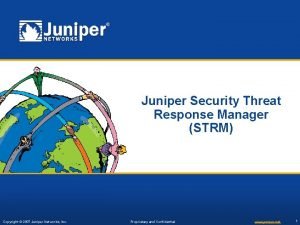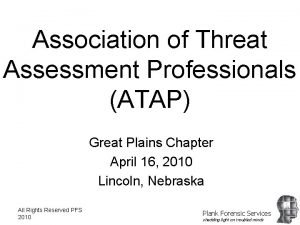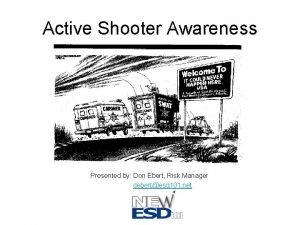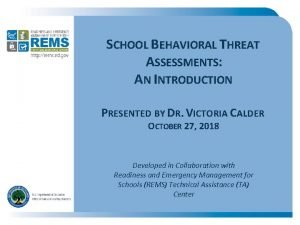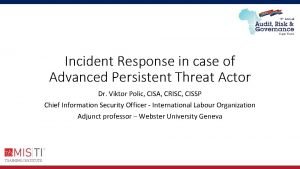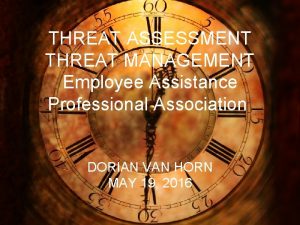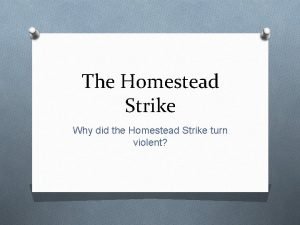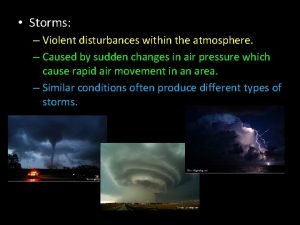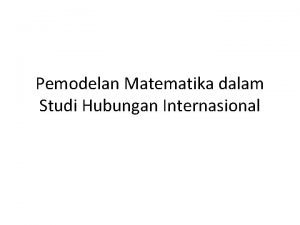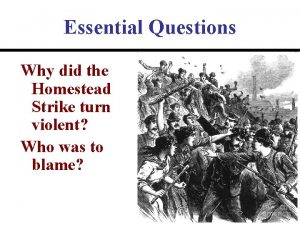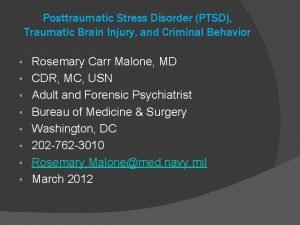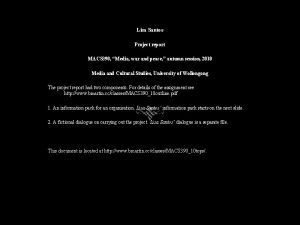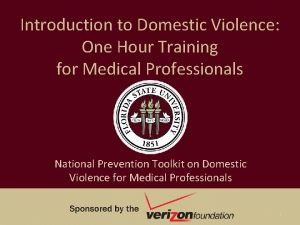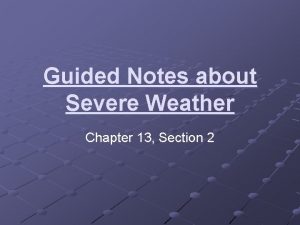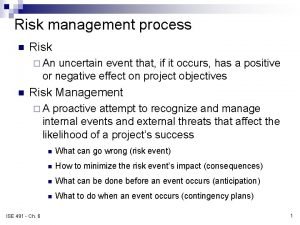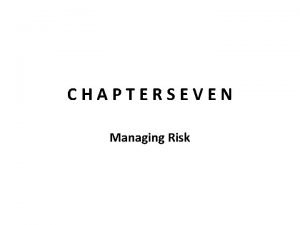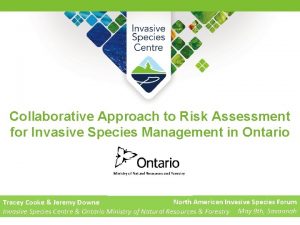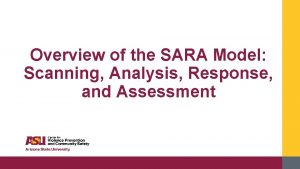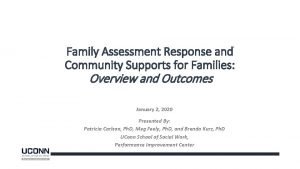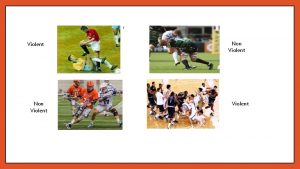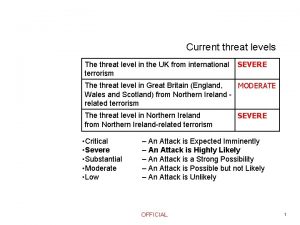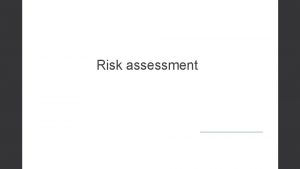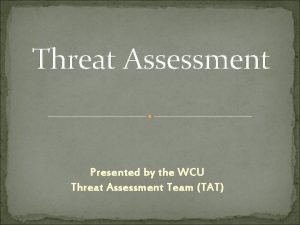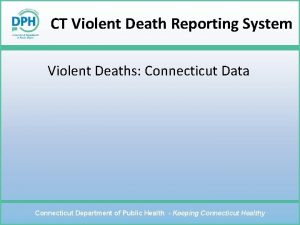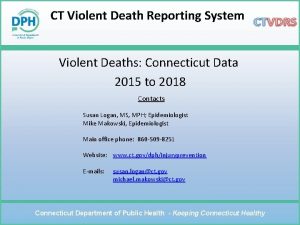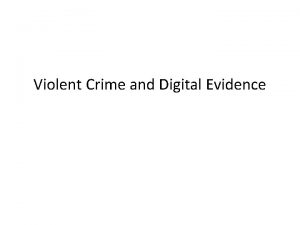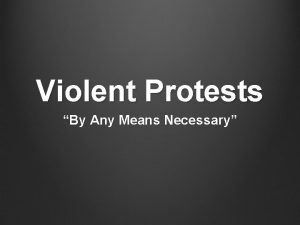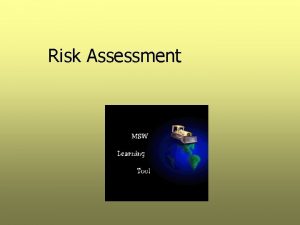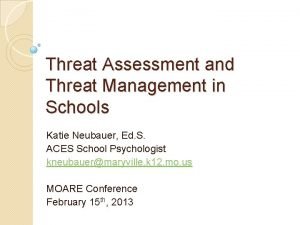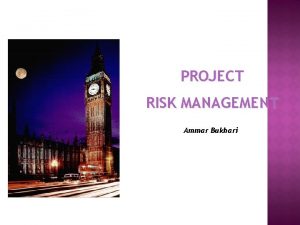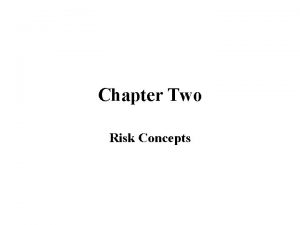Violent Threat Risk Assessment Response January 29 2016













































- Slides: 45

Violent Threat Risk Assessment & Response January 29, 2016 Presented by: Wanda Christensen Associate Superintendent, Student Services

Outcomes for Session ¨ Introduction ¨ Why do we need a VTRA protocol? ¨ What is a VTRA? ¨ How do we implement the VTRA protocol in CESD? ¨ How can bus drivers help? ¨ Case Studies ¨ Questions

When you hear … ‘Violence Threat Risk Assessment’ (VTRA) …what comes to mind?

When you hear…VTRA? Take a few minutes… 1. What do you already know? 2. What questions do you have?

INTRODUCTION Let‘s go back to 1999… Columbine School Shooting As you watch this video clip, please consider the following question: What ‘CLUES’ did “Police, School, Parents, Peers, and Others” know about regarding what Eric and Dillon were planning to do?

What did we learn from Columbine? ¨What ‘CLUES’ did “Police, School, Parents, Peers, and Others” know about regarding what Eric and Dillon were planning to do?

Why do we need a VTRA Protocol? ¨ Past school shootings have taught us many things… – People who commit violent acts NEVER just ‘SNAP’ (despite reports in media)…they always leave clues and messages with people, social media, etc. – The protocol empowers professionals, parents and caregivers to speak openly and communicate with each other – “Connecting the Dots” is critical to prevent serious violence

GURUS of this work… J. Kevin Cameron Executive Director – CCTATR Supt. Glenn Woods (Ret) RCMP Allan Campbell Consultant – CCTATR 8

History ¨ Columbine – April 20, 1999 Eight days after the Columbine School shooting… ¨ Taber, Alberta – April 28, 1999 A former W. R. Myers High School student in Taber, Alberta entered a side door to the school and opened fire on a small group of male students, killing one and seriously injuring one other ¨ La Loche, Saskatchewan – January 22, 2016 A 17 year old from La Loche entered school, opened fire and shot two students, a teacher and a teacher’s aide 9

History § Taber Response Project: § Two weeks after, Kevin Cameron was seconded to the Alberta Government Taber Response Project (TRP) § The sole purpose was to take the regional lead in understanding and recovering from the traumatic aftermath of the shooting 10

What is a VTRA? ¨ VTRA = “Violent Threat Risk Assessment” ¨ In CESD – our Admin Procedure 3 -26 “Welcoming, Respectful, Safe, Caring and Inclusive Schools” - guides our efforts ¨ Consistent way to address all levels and types of threats. ¨ Professionals, parents and others who know the child/youth gather together to share information and assess level of risk ¨ Newswatch_School. Protocol. wmv

What is a VTRA? ¨ Unique feature - uses ‘functional’ multi- disciplinary teams to assess level of threat and determine interventions ¨ Flexible – every community has a different range of resources ¨ Most people who make threats have no intentions of carrying them out (fortunately) ¨ However, EVERY THREAT is taken seriously and assessed in a timely manner 12

Threats are a Gift!? ¨ In the Threat Assessment world, threats are considered a ‘GIFT’. ¨ It is common for those who carry out violent acts to have a history of threat making behavior. ¨ This can be direct or indirect threats that come in many forms.

How do we IMPLEMENT the VTRA Protocol? ¨ Ensure VTRA Level One training is accessible to all of our School Administrators and Family School Wellness Workers on an annual basis ¨ Invite Community Partners – RCMP; CFSA; Mental Health; Probation officers ¨ VTRA Teams in schools ¨ Build and sustain relationships with Community Partners -

“VTRA” TEAMS ¨ SCHOOL: – Principal and/or Vice-Principal – Family School Wellness Worker – School Resource Officer (or RCMP Liaison Officer) ¨ DIVISION OFFICE: – First Contact: Associate Superintendent, Student Services – Wanda Christensen

“VTRA” TEAMS ¨ OTHER MEMBERS WHO MAY JOIN THE TEAM: – Teacher; Educational Assistant – Division Psychologist; Division Behaviour Consultant; FSW Clinical Team Lead – Child And Family Service Case Workers – Mental Health Therapists – Probation Officers

Who can refer to the VTRA Team? ¨ Referral to a VTRA team can come from any concerned individual. . . – Typically, the FSW, teacher or administrator will hear or learn about “threats or high risk behaviours” from students and/or parents – However, referrals can come from other concerned individuals like…bus drivers, coaches, mental health therapists, RCMP members or community leaders

If I have a concern, who do I contact? ¨ As a bus driver, the first person you need to talk to is School Administration ¨ And, you can always contact Dieter or Wanda too (if needed) – we will follow up with school admin

Three Primary Hypotheses in the VTRA Process: 1. Is it a conscious or unconscious “CRY for HELP”? 2. Conspiracy of two or more? (who else knows about it? Who else is involved? ) 3. Evidence of fluidity? (homicidal vs suicidal)

Zero Tolerance for ‘NOT’ responding to threat making behavior: ¨ This would include: – Death Threats – Suicide Threats – Threats to seriously injure/harm others/self – Violent Threats against people/property • Written-verbal-witnessed

Types of Threats: ¨ Direct Threat: “I am going to place a bomb in the school’s gym” ¨ Indirect Threat: “If I wanted to, I could kill everyone at this school” ¨ Veiled Threat: “We would be better off without you around here anymore” ¨ Conditional Threat: “If you don’t pay me I will place a bomb in the school”.

Four Pronged Assessment Model (Taken from FBI’s “The School Shooter: A Threat Assessment Perspective” ¨ Prong One: Personality of the student ¨ Prong Two: Family Dynamics ¨ Prong Three: School Dynamics and the student’s role in those dynamics ¨ Prong Four: Social Dynamics

Personality of the Student ¨ Low tolerance for • Change of behavior ¨ • Rigid and opinionated ¨ ¨ • Attitude of frustration superiority Poor coping skills • Exaggerated need Lack of resiliency for attention Failed love • Anger relationship Lack of empathy management • Intolerance Exaggerated sense of • Seeks to entitlement manipulate others • Lack of trust • Fascination with violence filled entertainment • Behavior appears relevant to carrying out a threat

Family Dynamics ¨ Turbulent Parent-Child Relationship ¨ Acceptance of Pathological Behavior ¨ Access to Weapons ¨ Lack of Intimacy ¨ Student “Rules the Roost” ¨ No Limits or Monitoring of TV, Internet, Video Game, etc. ¨ lost_children. wmv

School Dynamics ¨ Student’s Attachment to School ¨ Tolerance for Disrespectful Behavior ¨ Inequitable Discipline ¨ Inflexible Culture ¨ Pecking Order Among Students ¨ Code of Silence ¨ Unsupervised Computer Access

Social Dynamics ¨ Access to Media, Entertainment, Technology ¨ Peer Groups ¨ Drugs and Alcohol ¨ Outside Interests ¨ Copycat Effects ¨ Finland 2. wmv

Other FACTORS to consider: ¨ Fluidity between Suicidal Ideation and Homicidal Ideation ¨ Traditional/Mixed/Non Traditional ¨ Bullying leading to revenge ¨ Triggering Event (loss) ¨ Lack of Connection to an Adult ¨ Family/Social Role ¨ Empty Vessel

Levels of Risk ¨ Low Level Threat: Poses minimal risk to the victim and public safety. ¨ Medium Level: Threat which could be carried out, although it may not appear entirely realistic. ¨ High Level: Threat that appears to pose an imminent and serious danger to the safety of others. ¨ Consider how direct, detailed and plausible threat is… this determines the level of risk.

WELLNESS BREAK

The Elizabeth Bush Story What can we learn? ¨ Elizabeth Bush. wmv

Turn & Talk ¨ What ‘surprised’ you about the Elizabeth Bush story? ¨ What did we learn from ‘Elizabeth Bush”? ¨ What questions arise for you?

Critical Periods ¨ Critical Period 1: 2 weeks following any high profile violent trauma ¨ Critical Period 2: Mid November – Christmas ¨ Critical Period 3: Month prior to high profile anniversaries ¨ Critical Period 4: Anniversaries of local trauma events.

Protocol: Four Categories for Action: ¨ Immediate Risk Situations ¨ High-Risk Student Behaviors ¨ Worrisome Behaviors ¨ Exceptional Cases: High Profile Threat- related Behavior

Immediate Risk Situations ØWhen immediate risk is identified, the Principal will contact the RCMP and take steps to ensure the safety of all school members, as denoted in established protocols. (e. g. , the student has a weapon in their possession and poses a serious threat to others). ØThis is time for direct RCMP intervention, not “Risk Assessment”.

High Risk Student Behaviors ¨ A ‘High Risk’ threat is when there is a clear danger where a student has made a direct threat with clear targets, has detailed thought out plans and access to weapons or other resources to carry out that threat. ¨ These ‘High Risk’ behaviours would be reported to the Principal (or designate) who would consult with Wanda to consult and activate the VTRA protocol.

Worrisome Behaviors ¨ The majority of “high-risk behavior” falls into this category. ¨ Drawing pictures, writing stories, social media content & vague statements would fall into this category. ¨ These would be reported to the Principal (or designate) and/or Family School Wellness Worker who would consult with Wanda and other members of the team to determine course of action.

Exceptional Cases: High Profile ¨ Canadian schools are in the impact zone of high profile school shootings (Littleton, Colorado/ Taber, Alberta/ Newtown, Conneticut, La Loche, Saskatchewan). ¨ There may be some behaviour or threats that would be considered worriesome but in light of it’s context of these events, may be elevated. ¨ Also if a threat has a large audience it will be an exceptional case, as it will create significant anxiety within the community.

Students Who are Under Twelve Years of Age ¨ Students under the age of twelve who engage in threat related and high risk behaviors may not pose a significant risk, as developmental issues need to be taken into consideration. ¨ However, just because a student is under 12 years of age does not mean they cannot pose a risk. Generally speaking most threat related behavior exhibited by elementary aged students would fall into the third category of ‘worrisome behaviors’.

PREVENTION IS KEY – VTRA TEAMS ¨ What key messages do you hear about the VTRA process at the Maple High School – York Regional School Board (north of Toronto, Ontario)? ¨ CBC Video Guns in Car. wmv

How can Bus Drivers HELP? ¨ Share concerns with your Principal about any ‘concerns’ you may have about students. ¨ Be aware of ‘leakage’ (conversations between students) that may be worrisome. ¨ Keep an open mind that all communities are vulnerable to violent acts.

¨Ready to consider a couple of case studies? ¨Real life situations…

Case Study #1 ¨ On your morning route picking up students for school, you notice that Jack (grade 9) is very agitated. Jack is new on your bus route so you don’t know him or his parents very well. He immediately starts picking on a student near him. A verbal exchange of words takes place between the two students. You overhear Jack say, “Don’t make me mad because I have a gun in my back pack and I’m not afraid to use it”. ¨ Turn and Talk – What would you do?

Case Study #2 ¨ During the bus route home after school, you notice Mary (grade 7) is very sad and emotionally upset. ¨ Before she gets off the bus to go to her house, she passes you a piece of paper. ¨ On the paper is a poem written by Mary. It makes many references to her not wanting to live anymore. It states that she told her parents and they don’t do anything or don’t even care she is feeling this way. ¨ Turn and Talk – What would you do?

QUESTIONS?

 Oxymorons in romeo and juliet
Oxymorons in romeo and juliet These violent delights will have violent ends
These violent delights will have violent ends January 2018 chemistry regents answers
January 2018 chemistry regents answers Threat modeling tools microsoft
Threat modeling tools microsoft Market risk assessment
Market risk assessment Juniper strm
Juniper strm Association of threat assessment professionals
Association of threat assessment professionals Don ebert
Don ebert Behavioral threat assessment software
Behavioral threat assessment software Viktor polić
Viktor polić Employee threat assessment
Employee threat assessment Aswath damodaran erp
Aswath damodaran erp Natural response and forced response
Natural response and forced response Natural response and forced response example
Natural response and forced response example A subsequent
A subsequent If a child washes his hands, he could eat with kings.
If a child washes his hands, he could eat with kings. Why did the homestead strike fail
Why did the homestead strike fail Is a violent disturbance in the atmosphere
Is a violent disturbance in the atmosphere Pengertian model matematika
Pengertian model matematika Nvc cheat sheet
Nvc cheat sheet Why did the homestead strike turn violent?
Why did the homestead strike turn violent? Chapter 19 confusion dementia and alzheimer's disease
Chapter 19 confusion dementia and alzheimer's disease Ptsd violent behavior
Ptsd violent behavior Thesis statement gun control
Thesis statement gun control Not genuine, not true, not valid
Not genuine, not true, not valid Violent vs nonviolent restraints
Violent vs nonviolent restraints Non violent crisis intervention techniques
Non violent crisis intervention techniques Denotation and connotation
Denotation and connotation Word study denotation and connotation
Word study denotation and connotation Violent python 3
Violent python 3 Dr lisa santos
Dr lisa santos Violent incident report form
Violent incident report form Aristotle law of motion
Aristotle law of motion Conclusion of violence
Conclusion of violence Violent motion
Violent motion Do violent games cause violence
Do violent games cause violence Violent downdrafts that are concentrated in a local area
Violent downdrafts that are concentrated in a local area Word 2016 session 2 post assessment
Word 2016 session 2 post assessment Silver fiddle construction case study
Silver fiddle construction case study Risk response matrix
Risk response matrix Risk mitigation techniques in project management
Risk mitigation techniques in project management Adopting proven technology instead of experimental
Adopting proven technology instead of experimental Risk response
Risk response Selected response assessment
Selected response assessment Sara model
Sara model Family assessment response
Family assessment response





